Spatio-Temporal Dynamics of Feed Grain Demand of Dairy Cows in China
Abstract
1. Introduction
2. Literature Review
2.1. Study on the Supply and Demand of Feed Grain
2.2. Study on the Domestic Circulation and International Trade of Feed Grain
2.3. Research Review
3. Data and Methods
3.1. Data
3.1.1. Data Required for Feed Grain Demand Accounting
3.1.2. Data Required for Influencing Factors
3.1.3. Map Data
3.2. Feed Grain Conversion Ratio
3.3. Methods
3.3.1. Feed Grain Demand Estimation
3.3.2. Standard Deviational Ellipse
3.3.3. Hot Spot Analysis
3.3.4. The Geo-Detector Method
4. Spatio-Temporal Dynamics of DCFG Demand in China
4.1. Temporal Dynamics of DCFG Demand at the National Level
4.2. Spatio-Temporal Changes in DCFG at the Regional Level
4.3. Changing Spatial Distribution of DCFG Demand
4.4. Spatio-Temporal Dynamics of DCFG Demand at the Provincial Level
5. Results from the Geo-Detector Analysis
5.1. Resource Endowment
5.2. Feeding Scale
5.3. Feeding Technology
5.4. Market Environment
6. Conclusions and Discussion
6.1. Conclusions
6.2. Discussion
Author Contributions
Funding
Conflicts of Interest
References
- Mergos, G.J. Feed use of grain: On trends and determinants. Eur. Rev. Agric. Econ. 1989, 16, 1–17. [Google Scholar] [CrossRef]
- Spiertz, J.H.J.; Ewert, F. Crop production and resource use to meet the growing demand for food, feed and fuel: Opportunities and constraints. NJAS Wagening. J. Life Sci. 2009, 56, 281–300. [Google Scholar] [CrossRef]
- Godfray, H.C.J.; Beddington, J.R.; Crute, I.R.; Haddad, L.; Lawrence, D.; Muir, J.F.; Pretty, J.; Robinson, S.; Thomas, S.M.; Toulmin, C. Food security: The challenge of feeding 9 billion people. Science 2010, 327, 812–818. [Google Scholar] [CrossRef] [PubMed]
- Xin, L.J.; Wang, L.X.; Liu, A.M. Regional production and consumption equilibrium of feed grain in China and its policy implication. J. Nat. Resour. 2018, 33, 965–977. (In Chinese) [Google Scholar]
- Wang, M.L. China’s livestock industry development: Achievements, experiences and future trends. Issues Agric. Econ. 2018, 8, 60–70. (In Chinese) [Google Scholar]
- Rae, A. China’s agriculture, smallholders and trade: Driven by the livestock revolution? Aust. J. Agric. Resour. Econ. 2008, 52, 283–302. [Google Scholar] [CrossRef]
- Zhou, Z.Y.; Tian, W.M.; Malcolm, B. Supply and demand estimates for feed grains in China. Agric. Econ. 2008, 39, 111–122. [Google Scholar] [CrossRef]
- Tian, W.M.; Chudleigh, J. China’s feed grain market: Development and prospects. Agribus. Int. J. 1999, 15, 393–409. [Google Scholar] [CrossRef]
- Hou, X.Y.; Zhang, Y.J. Analysis on driving factors of improvement of quality and efficiency and transformation development of grasslands and animal husbandry industry. Chin. Sci. Bull. 2018, 63, 1632–1641. (In Chinese) [Google Scholar] [CrossRef]
- IDDCDA (Industry Development Department of China Dairy Association). 2017 China “School Milk Programme” Promotion and Exchange Conference Held. Available online: http://www.dac.com.cn/read/newxhdt1-17122507465539510742.jhtm (accessed on 25 April 2019).
- Liu, C.G. China Dairy Yearbook; China Agriculture Press: Beijing, China, 2006. (In Chinese) [Google Scholar]
- NBSC (National Bureau of Statistics of China). China Statistical Yearbook 2018; China Statistics Press: Beijing, China, 2018. (In Chinese)
- Liu, C.Q.; Han, L.; Zhang, Y.H. International comparison and development suggestions of China’s dairy industry competitiveness. Chin. Rural Econ. 2018, 7, 130–144. (In Chinese) [Google Scholar]
- RSID, NBSC (Rural Socioeconomic Investigation Department, National Bureau of Statistics of China). China Rural Statistical Yearbook 2018; China Statistics Press: Beijing, China, 2018. (In Chinese)
- Ministry of Agriculture of PRC. China Dairy Yearbook 2017; China Agriculture Press: Beijing, China, 2018. (In Chinese)
- Zhou, Z.Y.; Tian, W.M.; Liu, X.A.; Wan, G.H. An Issue of Debate: China’s Feedgrain Demand and Supply; AARC Working Paper Series No. 15; Asian Agribusiness Research Centre: The University of Sydney: Sydney, Australia, 2001. [Google Scholar]
- Han, X.R.; Chen, Y.F.; Qian, X.P. Demand of feed grain in China. J. Agrotech. Econ. 2014, 8, 60–68. (In Chinese) [Google Scholar]
- PDNDRC (Price Department of National Development and Reform Commission). National Assembly of Cost and Benefit Analysis of Agricultural Products 2018; China Statistics Press: Beijing, China, 2018. (In Chinese)
- Hu, X.D.; Wang, J.M. Estimation and structure of pig’s feed grain consumption in China. J. Agrotech. Econ. 2015, 10, 4–13. (In Chinese) [Google Scholar]
- Ding, X.M. Develop forage-saving feed-strategic choice on adjusting dietary pattern of urban and rural residents in China. China Soft Sci. 1991, 6, 41–44. (In Chinese) [Google Scholar]
- Li, H.M.; Li, B.; Tang, Q.Y. Influencing factors of maize yield in southern China-based on the survey of farmers in Hunan province. Chin. Rural Econ. 2010. (In Chinese) [Google Scholar]
- Ran, J.; Sun, Z. Feed grain consumed from 1984 to 2013 in China. Chin. Agric. Sci. Bull. 2017, 33, 153–158. (In Chinese) [Google Scholar]
- Xie, G.D.; Cheng, S.K.; Xiao, Y.; Lu, C.X.; Liu, X.J.; Xu, J. The balance between grain supply and demand and the reconstruction of China’s food security strategy in the new period. J. Nat. Resour. 2017, 32, 895–903. (In Chinese) [Google Scholar]
- Brown, L.R. Who Will Feed China? Wake-Up Call for a Small Planet; WW Norton & Company: New York, NY, USA, 1995. [Google Scholar]
- Tian, W.M.; Zhou, Z.Y. Methodology Issues on Studying the Feedgrain’s Supply and Demand; China Agriculture Press: Beijing, China, 2007. [Google Scholar]
- Aubert, C. Food security and consumption patterns in China: The grain problem. China Perspect. 2008, 2, 5–23. [Google Scholar] [CrossRef][Green Version]
- Qu, W.S. A Comparison Framework of Seven China Agriculture Models; Ash, K., Ma, X., Eds.; China in the Global Economy Agriculture in China and OECD Countries: Past Policies and Future Challenges; OECD–Organisation for Economic Co-operation and Development: Paris, France, 1999. [Google Scholar]
- Liu, N. Impact of population structure and food consumption differences on China’s food demand. Lanzhou Acad. J. 2015, 11, 164–170. (In Chinese) [Google Scholar]
- Crompton, P.; Phillips, B.; Gunasekera, D. Effect on feed grains of China’s rising demand for livestock products. Chin. Rural Econ. 1994, 3, 27–32. [Google Scholar]
- Yang, S.Q.; Yang, G.H.; Feng, Y.Z.; Yang, Z.L.; Gao, W.S. Demand prediction of agricultural products in northwest of China in 2010. Chin. J. Eco-Agric. 2007, 15, 159–161. (In Chinese) [Google Scholar]
- Zhou, D.W.; Liu, H.W.; Sun, H.X.; Zhong, R.Z. Meat supply security and strategy of guaranteeing the production of meat in China. Bull. Chin. Acad. Sci. 2013, 28, 733–739. (In Chinese) [Google Scholar]
- Yang, T.J.; Yang, N.; Zhu, C.H. A forecasting model for feed grain demand based on combined dynamic model. Comput. Intell. Neurosci. 2016, 2016, 1–6. [Google Scholar] [CrossRef] [PubMed]
- Ran, J.; Wang, J.M. Prediction and analysis of feed grain demand based on feed demand in China. J. China Agric. Univ. 2017, 22, 190–198. (In Chinese) [Google Scholar]
- Xin, X.; Wan, G.H.; Liu, X.R. China’s regional feed grain trade flows and responses to price changes. China Rural Surv. 2002, 1, 22–29. (In Chinese) [Google Scholar]
- Xin, X.; Jiang, N.H.; Zhou, Z.Y. The impact of livestock produce consume increases on grain market of fodder in China. Issues Agric. Econ. 2003, 1, 60–64. (In Chinese) [Google Scholar]
- Liang, S.M. Optimization of feed circulation - based on spatial equilibrium model and GIS network analysis. J. Agrotech. Econ. 2010, 1, 80–87. (In Chinese) [Google Scholar]
- RGRFGCS (Research Group on Reform of Feed Grain Circulation System). Reform of feed grain circulation system in China. Chin. Rural Econ. 1998, 8, 33–40. (In Chinese) [Google Scholar]
- Zhou, H.C.; Chen, D.Q.; Zhang, L.X. Pattern of Supply of Raw Grain Feed in China. Lanzhou Acad. J. 2011, 6, 66–71. (In Chinese) [Google Scholar]
- Tian, W.M.; Zhou, Z.Y. International agricultural trade reforms and implications on China’s feed grain demand. China Agric. Econ. Rev. 2003, 1, 202–224. [Google Scholar]
- Mao, X.F.; Liu, D.M.; Liu, J. The present and future picture of large scale grain import in China. China Soft Sci. 2016, 1, 59–71. (In Chinese) [Google Scholar]
- Gu, G.D.; Yin, J.H. Measurement of Chinese Food Trade Safety from the Non-Traditional Security Perspective. J. Zhejiang Univ. (Humanit. Soc. Sci.) 2014, 44, 35–49. (In Chinese) [Google Scholar]
- Zhao, J.X.; Pan, B.; Tian, H.Z. Drived by price difference or rigid demand: Motivation of the increase in China’s feed grain imports. Issues Agric. Econ. 2019, 5, 98–109. (In Chinese) [Google Scholar]
- Li, J.R.; Barrett, C.B. Distinguishing between equilibrium and integration in markets analysis. Soc. Sci. Electron. Publ. (SSRN) 1999. [Google Scholar] [CrossRef]
- Sun, B.M. Index system and model design of grain supply and demand forecast in China. Econ. Probl. 2012, 3, 39–43. (In Chinese) [Google Scholar]
- Li, G.X. Grain production capacity and national food security level in China in 2020. Chin. Rural Econ. 2014, 5, 4–12. (In Chinese) [Google Scholar]
- Fang, C.; Fuller, F.H. Feed-Grain Consumption by Traditional Pork-Producing Households in China; Food and Agricultural Policy Research Institute (FAPRI) Publications: Ames, IA, USA, 1998. [Google Scholar]
- Zhang, X.M.; Dong, Y.H.; Shen, W.Z. Estimation of the main livestock and poultry breeding and feed grain demand in China. Feed Res. 2015, 4, 8–11. (In Chinese) [Google Scholar]
- NGCC (National Geomatics Center of China). National Basic Geographic Database (1:100 Million). Available online: http://www.webmap.cn/commres.do?method=result100W (accessed on 25 April 2019).
- Fischer, M.M.; Getis, A. Handbook of Applied Spatial Analysis: Software Tools, Methods and Applications; Springer: Berlin, Germany, 2010. [Google Scholar]
- Cliff, A.D.; Processes, O.S. Spatial Processes, Models and Applications; Pion: London, UK, 1981. [Google Scholar]
- Wang, J.F.; Xu, C.D. Geodetector: Principle and prospective. Acta Geogr. Sin. 2017, 72, 116–134. (In Chinese) [Google Scholar]
- Wang, J.F.; Li, X.H.; Christakos, G.; Liao, Y.L.; Zhang, T.; Gu, X.; Zheng, X.Y. Geographical detectors-based health risk assessment and its application in the neural tube defects study of the Heshun region, China. Int. J. Geogr. Inf. Sci. 2010, 24, 107–127. [Google Scholar] [CrossRef]
- Liu, Y.S.; Yang, R. The spatial characteristics and formation mechanism of the county urbanization in China. Acta Geogr. Sin. 2012, 67, 1011–1020. (In Chinese) [Google Scholar]
- Wang, J.F.; Zhang, T.L.; Fu, B.J. A measure of spatial stratified heterogeneity. Ecol. Indic. 2016, 67, 250–256. [Google Scholar] [CrossRef]
- Yu, H.L.; Li, B.L. Analysis on international competitiveness and influencing factors of Chinese dairy products. J. Int. Trade 2011, 10, 14–24. (In Chinese) [Google Scholar]
- Dao, R.N.; Luo, Y.F. From resources to capital: The cause analysis of the regional structure change in China’s dairy industry. Res. Agric. Mod. 2016, 2, 205–213. (In Chinese) [Google Scholar]
- Sun, X.Z. Evolution and tendency of Chinese agricultural production pattern. China Popul. Resour. Environ. 2010, 20, 107–111. (In Chinese) [Google Scholar]
- Zhou, Z.Y.; Gao, M.J.; Li, Q.X.; Zhang, Q.; Luo, Q.Y. Estimation of the primary products demand in China based on the balanced diet. Chin. J. Agric. Resour. Reg. Plan. 2015, 4, 85–90. (In Chinese) [Google Scholar]
- Hu, X.P.; Guo, X.H. Analysis and forecast of China’s grain demand structure in 2020—Based on the perspective of nutrition standards. Chin. Rural Econ. 2010, 6, 4–15. (In Chinese) [Google Scholar]
- Wang, M.L. Comprehensively upgrade the dairy industry in China through promoting the development of alfalfa Industry. Issues Agric. Econ. 2010, 5, 22–26. (In Chinese) [Google Scholar]
- Liu, Y.N.; Shi, Y.H.; Yan, X.B.; Wang, C.Z.; Liang, M.G.; Zhou, L. Effect of alfalfa hay substituting for part of the concentrate, on the production of cows and economic profit. Acta Prataculturae Sin. 2013, 22, 190–197. (In Chinese) [Google Scholar]
- GOSC (General Office of the State Council of the People’s Republic of China). Opinions of the General Office of the State Council on Promoting the Revitalization of the Dairy Industry to Ensure the Quality and Safety of Dairy Products. 2018. Available online: http://www.gov.cn/zhengce/content/2018-06/11/content_5297839.htm (accessed on 27 April 2019).
- FAO Database. Production. Available online: http://www.fao.org/faostat/zh/#data (accessed on 27 April 2019).
- Wei, Y.J.; Zhu, J. International experience in the development of the dairy industry: An analysis from the perspective of supply agents. Chin. Rural Econ. 2019, 2, 115–130. (In Chinese) [Google Scholar]
- Liu, C.G. China Dairy Yearbook; China Agriculture Press: Beijing, China, 2011. (In Chinese) [Google Scholar]
- CNS (Chinese Nutrition Society). Dietary Guidelines for Chinese Residents (2016); People’s Medical Publishing House: Beijing, China, 2016. (In Chinese) [Google Scholar]
- Qiang, W.L.; Liu, A.M.; Cheng, S.K. An ecological and socio-economic impact assessment of China’s soybean trade based on multi-attributes theory. Resour. Sci. 2013, 11, 2174–2180. (In Chinese) [Google Scholar]
- Luo, Y.; Qiao, Y.H.; Wu, W.L. Environment impact assessment of organic and conventional soybean production with LCA method in China Northeast Plain. Acta Ecol. Sin. 2011, 23, 7170–7178. (In Chinese) [Google Scholar]
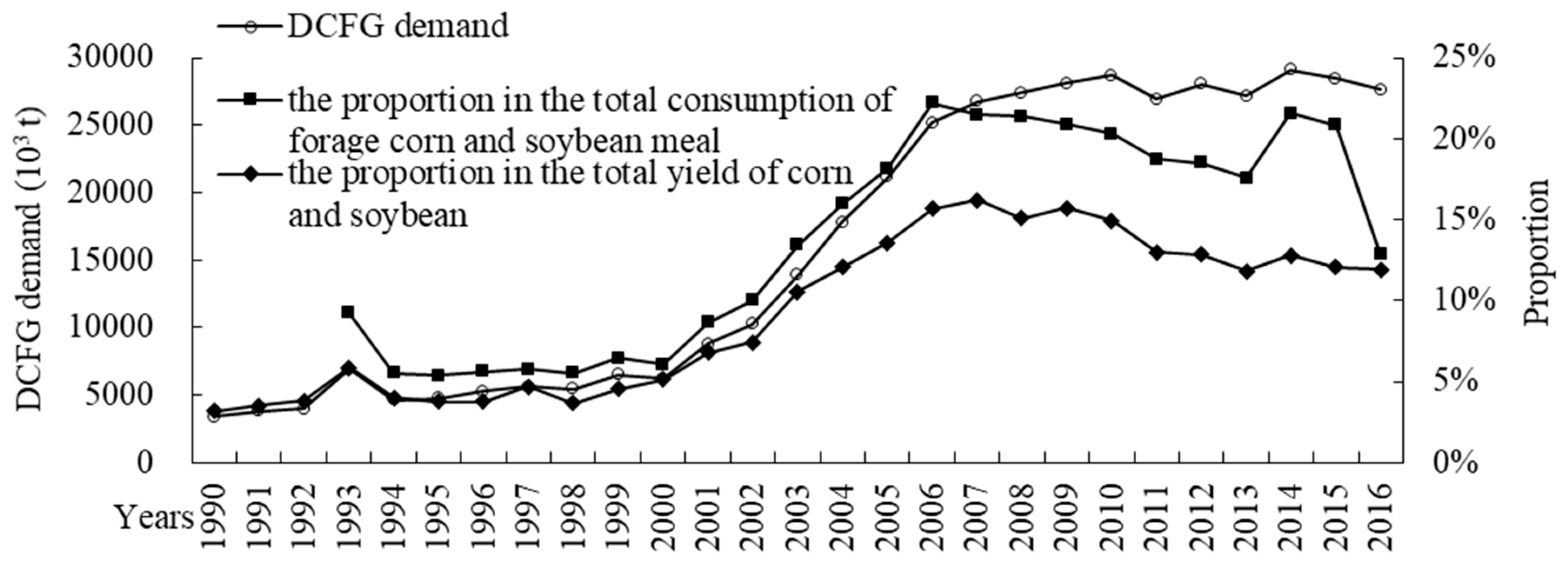
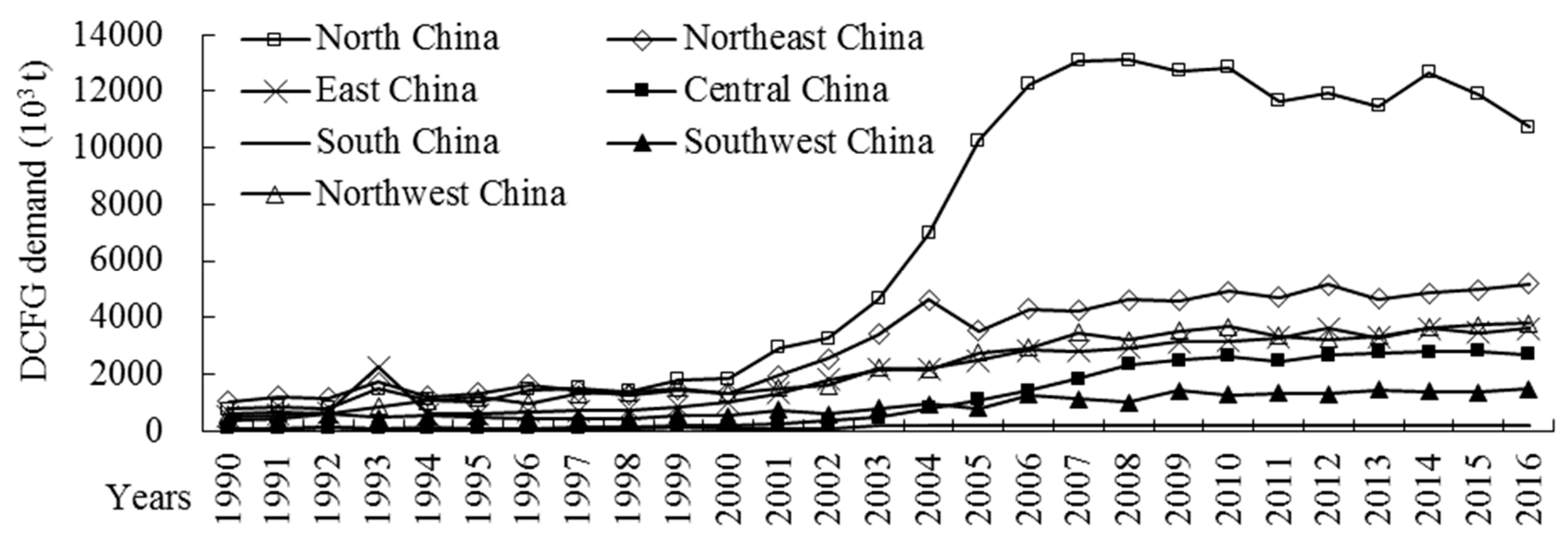
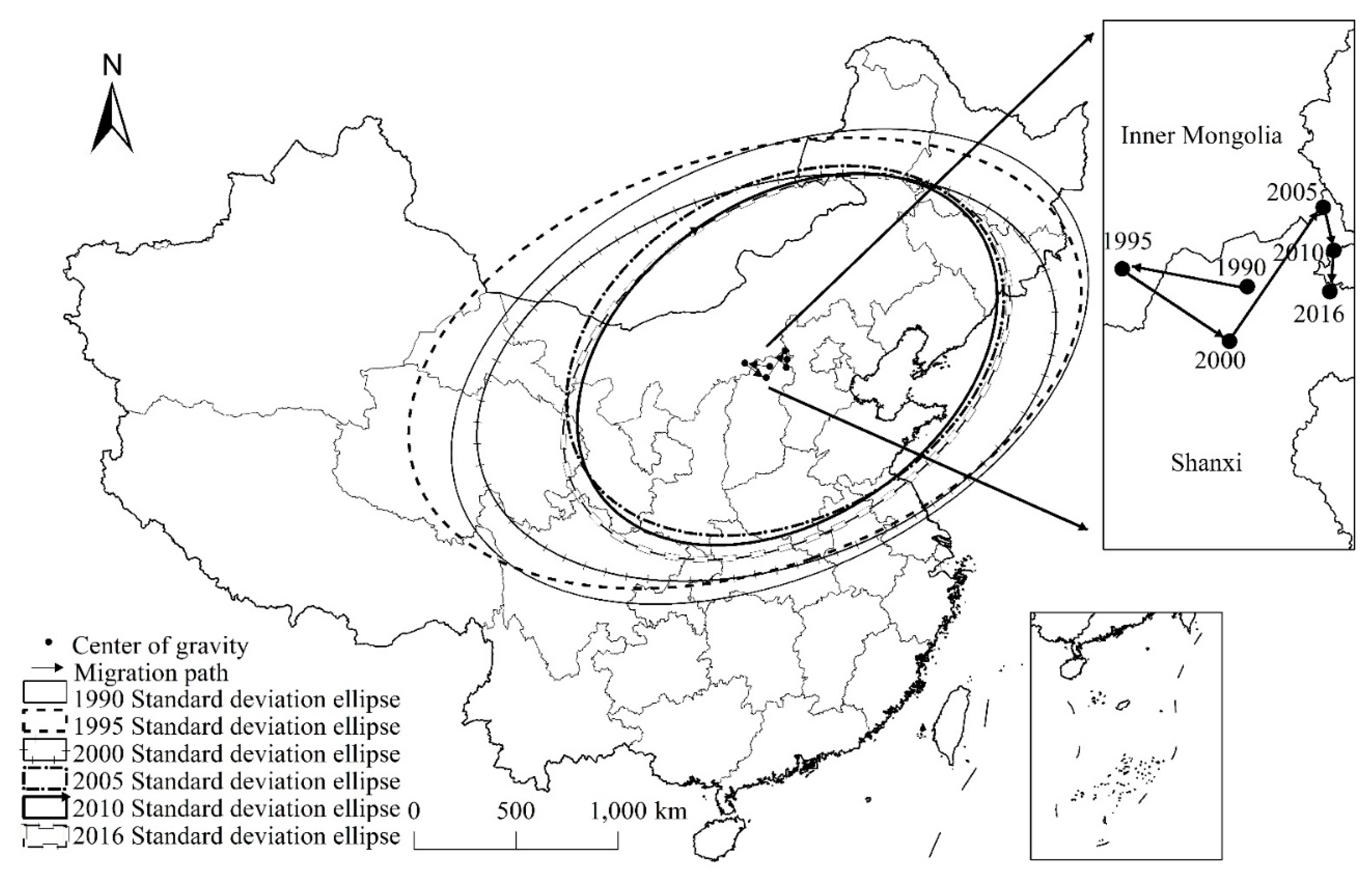
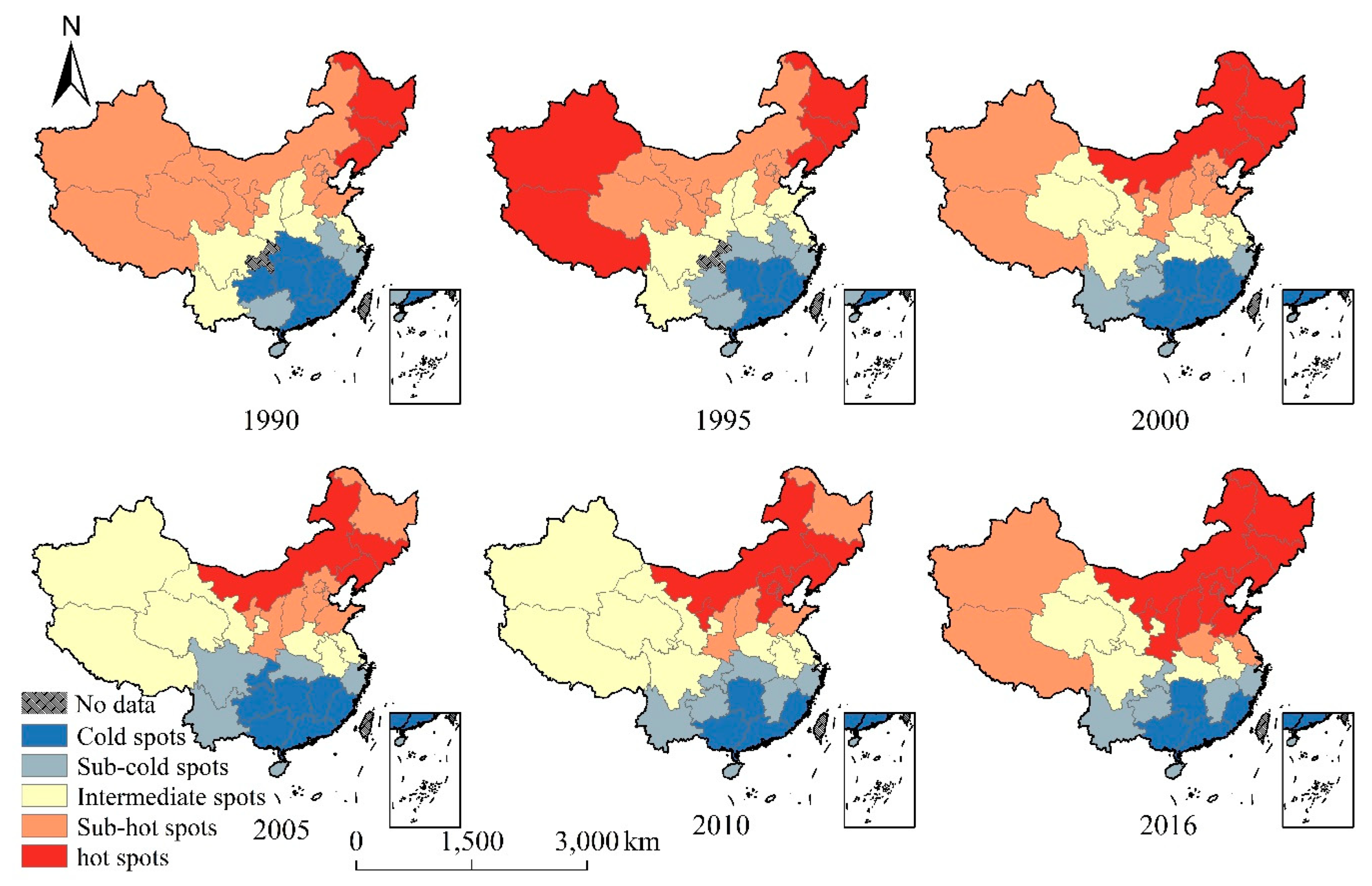
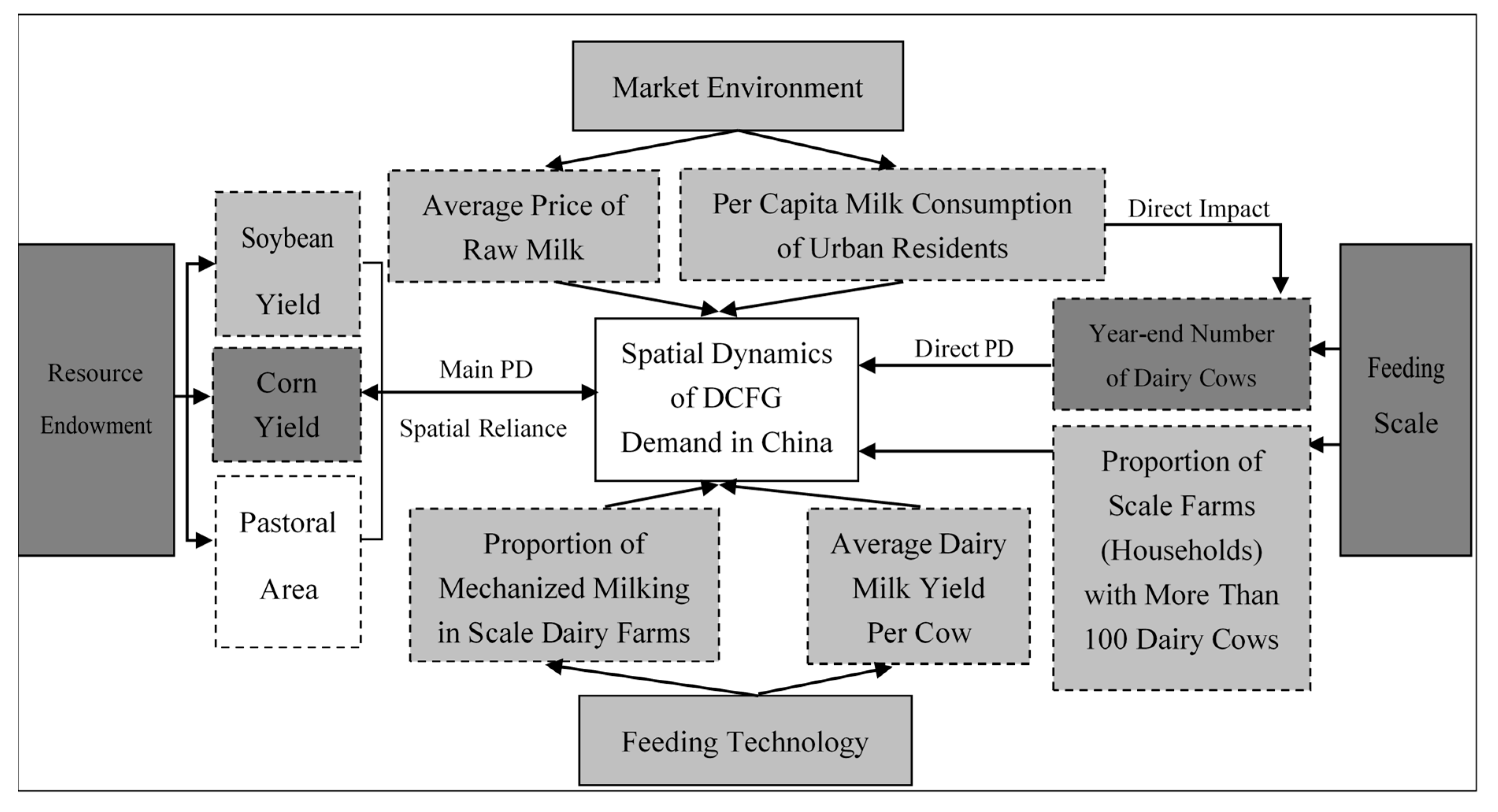
| Years | Feed Grain Conversion Ratio | Years | Fed Grain Conversion Ratio | Years | Feed Grain Conversion Ratio |
|---|---|---|---|---|---|
| 1990 | 0.39 | 1999 | 0.46 | 2008 | 0.37 |
| 1991 | 0.39 | 2000 | 0.40 | 2009 | 0.37 |
| 1992 | 0.45 | 2001 | 0.40 | 2010 | 0.38 |
| 1993 | 0.49 | 2002 | 0.37 | 2011 | 0.38 |
| 1994 | 0.48 | 2003 | 0.39 | 2012 | 0.38 |
| 1995 | 0.41 | 2004 | 0.37 | 2013 | 0.39 |
| 1996 | 0.42 | 2005 | 0.38 | 2014 | 0.38 |
| 1997 | 0.45 | 2006 | 0.39 | 2015 | 0.37 |
| 1998 | 0.42 | 2007 | 0.37 | 2016 | 0.37 |
| Provinces | Feed Grain Conversion Ratio | Provinces | Feed Grain Conversion Ratio | ||
|---|---|---|---|---|---|
| Range | Mean | Range | Mean | ||
| Beijing | 0.25–0.81 | 0.38 | Hubei | 0.27–0.52 | 0.38 |
| Tianjin | 0.32–0.57 | 0.42 | Hunan | 0.21–1.33 | 0.59 |
| Hebei | 0.35–0.57 | 0.41 | Guangdong | 0.21–0.78 | 0.44 |
| Shanxi | 0.28–0.63 | 0.39 | Guangxi | 0.26–0.57 | 0.39 |
| Inner Mongolia | 0.16–0.81 | 0.37 | Hainan | 0.37–1.68 | 0.48 |
| Liaoning | 0.24–0.39 | 0.34 | Chongqing | 0.26–0.57 | 0.42 |
| Jilin | 0.26–0.47 | 0.36 | Sichuan | 0.26–0.57 | 0.41 |
| Heilongjiang | 0.30–0.55 | 0.36 | Guizhou | 0.30–0.66 | 0.46 |
| Shanghai | 0.32–0.54 | 0.39 | Yunnan | 0.22–0.67 | 0.38 |
| Jiangsu | 0.27–0.47 | 0.37 | Tibet | 0.31–0.67 | 0.40 |
| Zhejiang | 0.25–0.49 | 0.40 | Shaanxi | 0.28–0.57 | 0.40 |
| Anhui | 0.26–0.62 | 0.38 | Gansu | 0.13–0.80 | 0.40 |
| Fujian | 0.30–0.49 | 0.36 | Qinghai | 0.29–0.61 | 0.39 |
| Jiangxi | 0.32–0.56 | 0.40 | Ningxia | 0.25–0.64 | 0.42 |
| Shandong | 0.21–0.48 | 0.38 | Xinjiang | 0.26–0.56 | 0.37 |
| Henan | 0.22–0.67 | 0.39 | - | - | - |
| Years | Major Axis (km) | Minor Axis (km) | Rotation (°) | Barycentric Coordinates | Migration Distance (km) | Elliptical Area (103 km2) |
|---|---|---|---|---|---|---|
| 1990 | 1022.77 | 1656.83 | 64.76 | 113.13° E, 39.93° N | — | 532.32 |
| 1995 | 1012.18 | 1706.67 | 71.21 | 111.71° E, 40.14° N | 123.62 | 542.65 |
| 2000 | 925.13 | 1467.40 | 70.82 | 112.90° E, 39.46° N | 126.78 | 426.45 |
| 2005 | 817.11 | 1140.50 | 60.53 | 114.06° E, 40.59° N | 160.32 | 292.75 |
| 2010 | 779.52 | 1131.39 | 54.92 | 114.15° E, 40.20° N | 43.46 | 277.05 |
| 2016 | 803.12 | 1200.26 | 56.43 | 114.07° E, 39.84° N | 40.34 | 302.81 |
| Main Elements | Variables | 1990 | 1995 | 2000 | 2005 | 2010 | 2016 |
|---|---|---|---|---|---|---|---|
| Resource endowment | X1 | 0.15 | 0.18 | 0.30 | 0.41 | 0.50 | 0.61 |
| X2 | 0.14 | 0.12 | 0.09 | 0.22 | 0.24 | 0.25 | |
| X3 | - | - | - | 0.10 | 0.08 | 0.08 | |
| Feeding scale | X4 | - | - | 0.59 | 0.48 | 0.59 | 0.68 |
| X5 | - | - | - | - | 0.16 | 0.19 | |
| Feeding technology | X6 | - | - | - | 0.10 | 0.15 | - |
| X7 | - | - | - | - | 0.07 | 0.23 | |
| Market environment | X8 | - | - | 0.29 | 0.12 | 0.20 | - |
| X9 | - | - | - | - | 0.13 | 0.23 |
© 2020 by the authors. Licensee MDPI, Basel, Switzerland. This article is an open access article distributed under the terms and conditions of the Creative Commons Attribution (CC BY) license (http://creativecommons.org/licenses/by/4.0/).
Share and Cite
Dong, C.Y.; Ma, B.B.; LU, C.X. Spatio-Temporal Dynamics of Feed Grain Demand of Dairy Cows in China. Sustainability 2020, 12, 663. https://doi.org/10.3390/su12020663
Dong CY, Ma BB, LU CX. Spatio-Temporal Dynamics of Feed Grain Demand of Dairy Cows in China. Sustainability. 2020; 12(2):663. https://doi.org/10.3390/su12020663
Chicago/Turabian StyleDong, Chao Yang, Bei Bei Ma, and Chun Xia LU. 2020. "Spatio-Temporal Dynamics of Feed Grain Demand of Dairy Cows in China" Sustainability 12, no. 2: 663. https://doi.org/10.3390/su12020663
APA StyleDong, C. Y., Ma, B. B., & LU, C. X. (2020). Spatio-Temporal Dynamics of Feed Grain Demand of Dairy Cows in China. Sustainability, 12(2), 663. https://doi.org/10.3390/su12020663





